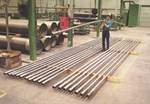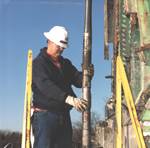Catenary Composite Risers
Catenary risers are able to absorb much more motion than top-tensioned risers, and, thus, are a common solution for wells tied back to an FPSO. Such a vessel experiences very high first-order motion in response to initial contact with wind or waves, making catenary risers a better solution than rigid component
Catenary risers are able to absorb much more motion than top-tensioned risers, and, thus, are a common solution for wells tied back to an FPSO. Such a vessel experiences very high first-order motion in response to initial contact with wind or waves, making catenary risers a better solution than rigid components. Catenary risers are an especially attractive option because they can be spooled and are less expensive to install.
ABB Offshore Systems is addressing these issues in the design and development of a fully bonded carbon fiber/thermoplastic composite catenary production riser system. This riser can handle production temperatures up to 320°F/160°C in water depths to 6,500 ft/2,000 m. In addition, its reelable diameter is 36 ft/11m, allowing it to be installed by a variety of existing vessels.
After consideration of mechanical properties and manufacturing issues, says Lars Slagsvold, project manager for composite risers, a thermoplastic liner was chosen because it is able to meet the requirements of extreme chemical inertness when exposed to high-temperature well fluid. During manufacture, the thermoplastic pipe liner acts as a mandrel for the carbon fiber/thermoplastic laminate layer; in service it will function as a fluid barrier. A thermoplastic outer liner will be applied to the outside of the riser, to protect the pipe during handling and in service. Two short pipe sections — one 4.4 inches/112 mm in diameter and a second one 7.2 inches/183 mm in diameter — were fabricated with available thermoplastic winding technology and extensively tested. Pipes were instrumented with strain gauges and acoustic emission microphones, then loaded sequentially at progressively higher values of internal, external and bending stress. Results showed that the riser samples easily accommodated an internal pressure of 7,000 psi/50 MPa and external pressure of 2,175 psi/15 MPa, and could bend to a radius of 15 ft/4.6 m (a 1.5 percent strain).
“The final composite properties have been shown to be strongly dependent on the processing conditions, so our manufacturing methods and the thermoplastic tape quality will be key,” says Slagsvold. High-quality carbon fiber-reinforced thermoplastic tape is manufactured by Sulzer Composites (Winterthur, Switzerland) for offshore tubular applications like ABB Offshore’s riser.
In the project’s final phase, a prototype will be fabricated. Once this is accomplished (sometime in 2002), the company will launch a program of large-scale testing. A prototype production plant is under construction to manufacture the continuous, one-piece pipes in any length. The program’s ultimate goal is to have this plant in place by 2003.
Related Content
-
Infinite Composites: Type V tanks for space, hydrogen, automotive and more
After a decade of proving its linerless, weight-saving composite tanks with NASA and more than 30 aerospace companies, this CryoSphere pioneer is scaling for growth in commercial space and sustainable transportation on Earth.
-
Natural fiber composites: Growing to fit sustainability needs
Led by global and industry-wide sustainability goals, commercial interest in flax and hemp fiber-reinforced composites grows into higher-performance, higher-volume applications.
-
Sulapac introduces Sulapac Flow 1.7 to replace PLA, ABS and PP in FDM, FGF
Available as filament and granules for extrusion, new wood composite matches properties yet is compostable, eliminates microplastics and reduces carbon footprint.














